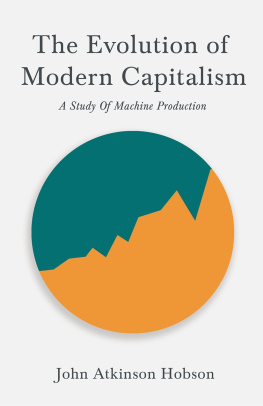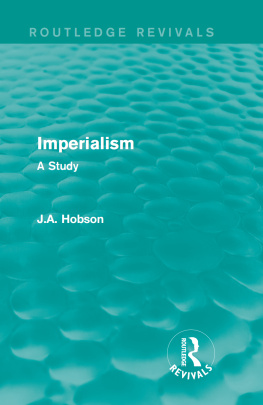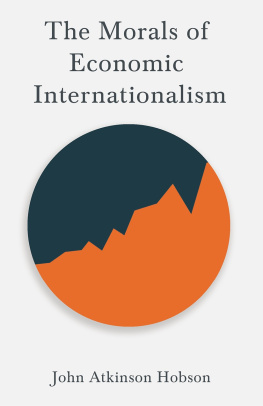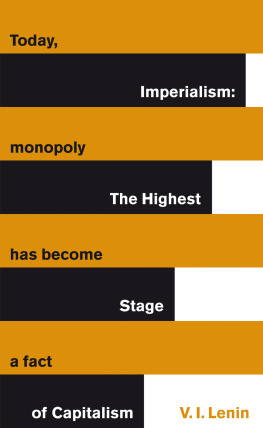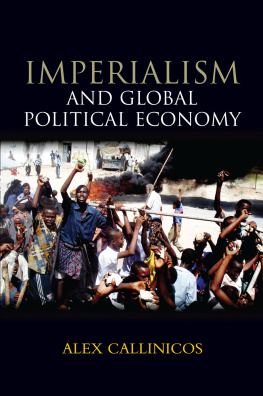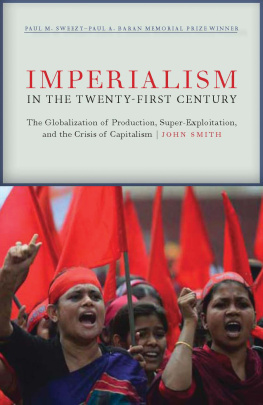THE
EVOLUTION
of
MODERN CAPITALISM
A STUDY OF
MACHINE PRODUCTION
WITH AN EXCERPT FROM
Imperialism,
The Highest Stage Of Capitalism
BY V. I. LENIN
By
JOHN A. HOBSON
First published in 1902
This edition published by Read Books Ltd.
Copyright 2019 Read Books Ltd.
This book is copyright and may not be
reproduced or copied in any way without
the express permission of the publisher in writing
British Library Cataloguing-in-Publication Data
A catalogue record for this book is available
from the British Library
Contents
The Highest
Stage Of Capitalism
AN EXCERPT FROM
Imperialism,
The Highest Stage Of Capitalism
BY V. I. LENIN
During the past fifteen or twenty years, especially after the Spanish-American War (1898) and the Anglo-Boer War (1899-1902), the economic and also the political literature of the old and new world has more and more often adopted the term imperialism in order to characterise the epoch in which we live. In 1902, Imperialism, a work by English economist, J. A. Hobson, was published in London and New York. The author, who adopts the point of view of bourgeois social reformism and pacifism, which in essence is identical with the present position of the ex-Marxist, K. Kautsky, gives a very good and detailed description of the principal economic and political characteristics of imperia lism....
Hobson, in his work on imperialism, marks the years 1884-1900 as being the period of intensified expansion of the chief European states. According to his estimate, England during these years acquired 3.7 million square miles of territory with a population of 57 million ; France acquired 3.6 million ; Germany one million square miles with 16.7 million inhabitants ; Belgium 900,000 square miles with 30 million inhabitants ; Portugal 800,000 square miles with 9 million inhabitants. The quest for colonies by all capitalist states at the end of the nineteenth century, and particularly since the 1880's, is a well-known fact in the history of diplomacy and of foreig n policy.
PREFACE.
In seeking to express and illustrate some of the laws of the structural changes in modern industry, I have chosen a focus of study between the wider philosophic survey of treatises on Social Evolution and the special studies of modern machine-industry contained in such works as Babbage's Economy of Manufactures and Ure's Philosophy of Manufactures, or more recently in Professor Schulze-Gaevernitz's careful study of the cotton industry. By using the term "evolution" I have designed to mark the study as one of a subject-matter in process of organic change, and I have sought to trace in it some of those large movements which are characteristic of all natura l growth.
The sub-title, A Study of Machine-Production, indicates a further narrowing of the investigation. Selecting the operation of modern machinery and motors for special attention, I have sought to enforce a clearer recognition of organic unity, by dwelling upon the more material aspects of industrial change which mark off the last century and a half from all former industrial epochs. The position of central importance thus assigned to machinery as a factor in industrial evolution may beto some extent must bedeceptive, but in bringing scientific analysis to bear upon phenomena so complex and so imperfectly explored, it is essential to select some single clearly appreciable standpoint, even at the risk of failing to present the full complexity of forces in their just but bewildering int eraction.
In tracing through the Business, the Trade, and the Industrial Organism the chief structural and functional changes which accompany machine-development, I have not attempted to follow out the numerous branches of social investigation which diverge from the main line of inquiry. Two studies, however, of "the competitive system" in its modern working are presented; one examining the process of restriction, by which competition of capitals gives way to different forms of combination; the other tracing in periodic Trade Depressions the natural outcome of unrestricted competition in private capitalist pr oduction.
In some final chapters I have sought to indicate the chief bearings of the changes of industrial structure upon a few of the deeper issues of social life, in particular upon the problem of the Industrial Town, and the position of woman as an industrial co mpetitor.
A portion of Chapters VIII., IX., and X. have already appeared in the Contemporary Review and in the Political Science Quarterly Review, and I am indebted to the courtesy of the editors for permission to use them.
I have also to acknowledge most gratefully the valuable assistance rendered by Dr. William Smart of Glasgow University, who was kind enough to read through the proofs of a large portion of this book, and to make many serviceable corrections and sug gestions.
John A . Hobson.
CHAPTER I.
INTRODUCTION.
1. Industrial Science, its Standpoint and Methods of Advance.
2. Capital as Factor in Modern Industrial Changes.
3. Place of Machinery in Evolution of Capitalism.
4. The Monetary Aspect of Industry.
5. The Literary Presentment of Organic Movement.
1. Science is ever becoming more and more historical in the sense that it becomes more studiously anxious to show that the laws or principles with whose exposition it is concerned not merely are rightly derived from observation of phenomena but cover the whole range of these phenomena in the explanation they afford. So likewise History is ever becoming more scientific in the sense that facts or phenomena are so ordered in their setting as to give prominence to the ideas or principles which appear to relate them and of which they are the outward expression. Thus the old sharp line, of distinction has slipped away, and we see there is no ultimate barrier between a study of facts and a study of the laws or principles which dominate these facts. In this way the severance of History and Science becomes less logically justifiable. Yet it is still convenient that we should say of one branch of study that it is historical in the sense that it is directly and consciously engaged in the collection and clear expression of facts or phenomena as they stand objectively in place or time without any conscious reference to the laws which relate or explain them; of another branch of study that it is scientific because it is engaged in the discovery, formulation, and correct expression of the laws according to which facts are related, without affecting to give a full presentment of those facts. The treatment in this book belongs in this sense to economic science rather than to industrial history as being an endeavour to discover and interpret the laws of the movement of industrial forces during the period of the eighteenth and nineteenth c enturies.
It cannot, however, be pretended that any high degree of exactitude can attach to such a scientif ic study.
Two chief difficulties beset any attempt to explain industrial phenomena by tracing the laws of the action of the forces manifested in them. The first is that only a limited proportion of the phenomena which at any given time constitute Industry are clearly and definitely ascertainable, and it may always be possible that the laws which satisfactorily explain the statical and dynamical relations of these may be subordinate or even counteracting forces of larger movements whose dominance would appear if all parts of the industrial whole were equal ly known.

